BUICK REGAL 1994 Owners Manual
Manufacturer: BUICK, Model Year: 1994, Model line: REGAL, Model: BUICK REGAL 1994Pages: 308, PDF Size: 15.78 MB
Page 211 of 308
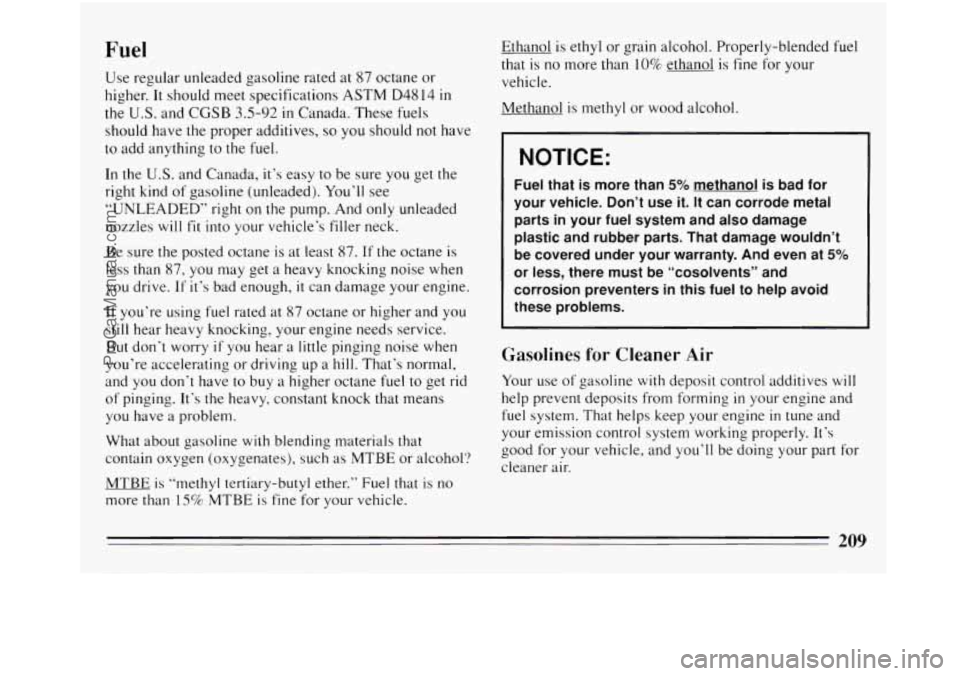
Fuel
Use regular unleaded gasoline rated at 87 octane or
higher. It should meet specifications ASTM
D48 14 in
the U.S. and CGSB 3.5-92 in Canada. These fuels
should have the proper additives,
so you should not have
to add anything to the fuel.
In the
U.S. and Canada, it’s easy to be sure you get the
right kind of gasoline (unleaded).
You’ll see
“UNLEADED” right on the pump. And only unleaded
nozzles
will fit into your vehicle’s filler neck.
Be sure the posted octane
is at least 87. If the octane is
less than 87,
you may get a heavy knocking noise when
you drive. If it’s bad enough, it can damage your engine.
If you’re using fuel rated at 87 octane or higher and you
still hear heavy knocking, your engine needs service.
But don’t worry if you hear a little pinging noise when
you’re accelerating or driving up a hill. That’s normal,
and you don’t have
to buy a higher octane fuel to get rid
of pinging. It’s the heavy, constant knock that means
you have a problem.
What about gasoline
with blending materials that
contain oxygen (oxygenates), such as MTBE or alcohol?
MTBE is “methyl tertiary-butyl ether.” Fuel that is no
more than
15% MTBE is fine for your vehicle. Ethanol
is ethyl or grain alcohol. Properly-blended fuel
that is no more than
10% ethanol is fine for your
vehicle.
Methanol is methyl or wood alcohol.
I NOTICE:
Fuel that is more than 5% methanol is bad for
your vehicle. Don’t use it. It can corrode metal
parts in your fuel system and also damage
plastic and rubber parts. That damage wouldn’t
be covered under your warranty. And even at
5%
or less, there must be “cosolvents” and
corrosion preventers in this fuel to help avoid
these problems.
Gasolines for Cleaner Air
Your use of gasoline with deposit control additives will
help prevent deposits from forming in your engine and
fuel system. That helps keep your engine
in tune and
your emission control system working properly. It’s
good for your vehicle, and you’ll be doing your part for
cleaner air.
209
ProCarManuals.com
Page 212 of 308
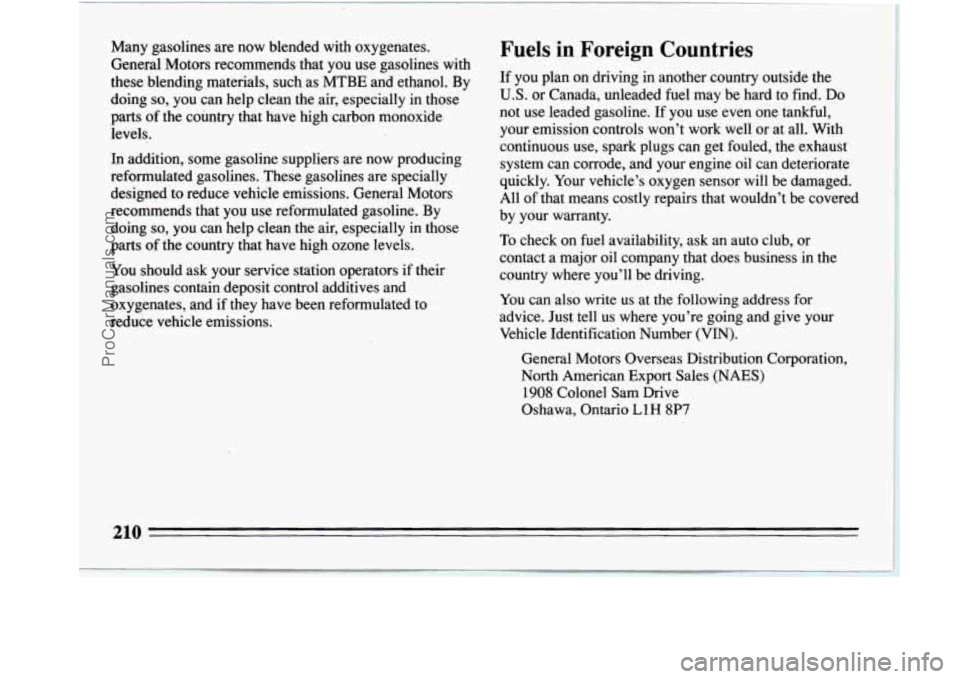
Many gasolines are now blended with oxygenates.
General Motors recommends that
you use gasolines with
these blending materials, such as MTBE and ethanol. By
doing
so, you can help clean the air, especially in those
parts of the country that have high carbon monoxide.
levels.
In addition, some gasoline suppliers are now producing
reformulated gasolines. These gasolines are specially
designed to reduce vehicle emissions. General Motors
recommends that you use reformulated gasoline. By
doing
so, you can help clean the air, especially in those
parts of the country that have high ozone levels.
You should ask your service station operators if their
gasolines contain deposit control additives and
oxygenates, and if they have been reformulated to
reduce vehicle emissions.
Fuels in Foreign Countries
If you plan on driving in another country outside the
U.S. or Canada, unleaded fuel may be hard to find. Do
not use leaded gasoline. If you use even one tankful, your emission controls won’t work well or at all. With
continuous use, spark plugs can get fouled, the exhaust
system can corrode, and your engine oil can deteriorate
quickly. Your vehicle’s oxygen sensor will be damaged.
All
of that means costly repairs that wouldn’t be covered
by your warranty.
To check on fuel availability, ask an auto club, or
contact a major oil company that does business in the
country where you’ll be driving.
You can also write
us at the following address for
advice. Just tell
us where you’re going and give your
Vehicle Identification Number
(VIN).
General Motors Overseas Distribution Corporation,
North American Export Sales (NAES)
1908 Colonel Sam Drive
Oshawa, Ontario
L1H 8P7
210
ProCarManuals.com
Page 213 of 308
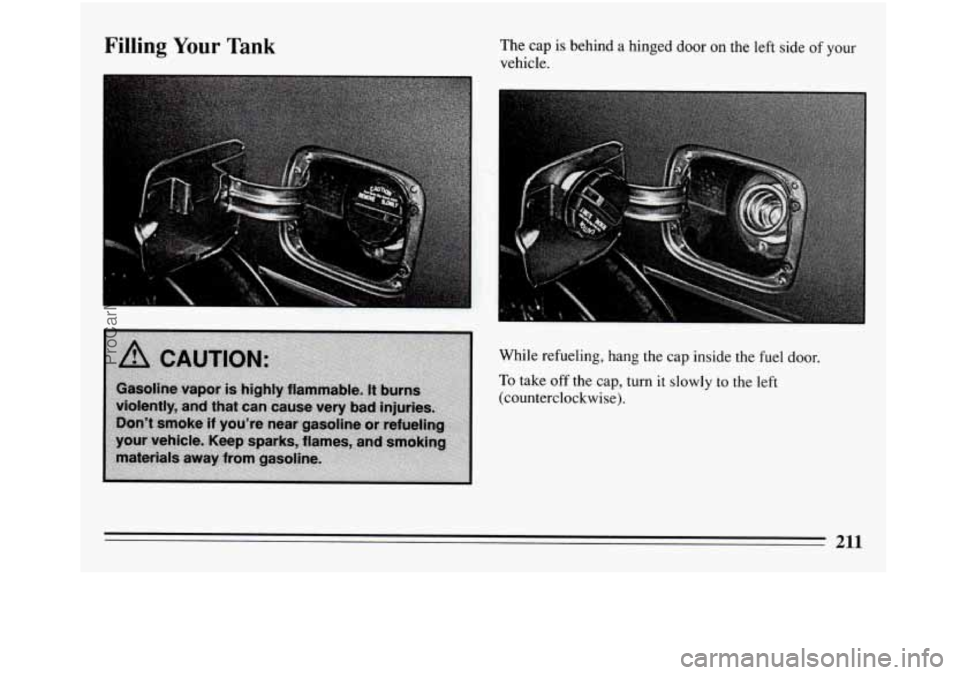
Filling Your Tank
I
I
I
I
The cap is behind a hinged door on the left side of your
vehicle.
While refueling, hang the cap inside the fuel door.
To take off the cap, turn it slowly to the left
(counterclockwise).
211
ProCarManuals.com
Page 214 of 308

Checking Things Under the Hood
Be careful not to spill gasoline. Clean gasoline from
painted surfaces as soon as possible. See “Cleaning the
Outside
of Your Buick” in the Index.
When you put.the cap back on, turn it to the right until
you hear
a clicking noise.
NOTICE:
If you need a new cap, be sure to get the right
type. Your dealer can get one for you.
If you get
the wrong type, it may not fit or have proper
venting, and your
fuel tank and emissions
system might be damaged.
Hood Release
1
To open the hood, first pull
the handle inside the
vehicle. It is located on the
floor next to the driver’s
seat.
212
ProCarManuals.com
Page 215 of 308
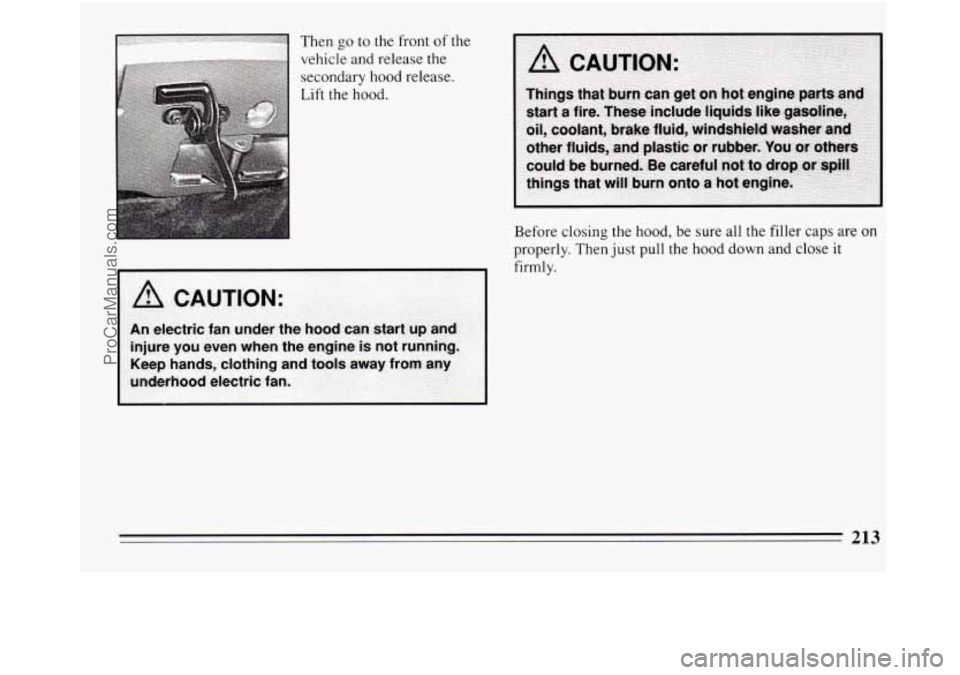
Then go to the front of the
vehicle and release the
secondary hood release.
Lift the hood.
Before closing the hood,
be sure all the filler caps are on
properly. Then just pull the hood down and close it
firmly.
213
ProCarManuals.com
Page 216 of 308

Engine Oil
LOW
OIL
If the “LOW OIL” light on the instrument panel comes
on,
it means you need to check your engine oil level
right away. For more information, see
“LOW OIL” light
in the Index. You should check your engine oil level
regularly; this
is an added reminder.
It’s a good idea
to check your engine oil every time you
get fuel. In order to get an accurate reading, the oil must
be warm and the vehicle
must be on level ground. The
engine oil dipstick is located near the front and
center of the engine compartment.
Turn off the engine and give the oil
a few minutes to
drain back into the oil pan. If you don’t, the oil dipstick
might not show the actual level.
214
ProCarManuals.com
Page 217 of 308

To Check Engine Oil
Pull out the dipstick and clean it with a paper towel or
cloth, then push
it back in all the way. Remove it again,
keeping the tip lower, and check the level.
A
A
r
When to Add Oil
If the oil is at or below the ADD line, then you’ll need
to add some oil. But you must use the right kind. This
section explains what kind of oil
to use. For crankcase
capacity, see “Capacities and Specifications’’
in the
Index.
NOTICE:
Don’t add too much oil. If your engine has so
much oil that the oil level gets above the
cross-hatched area that shows the proper
operating range, your engine could be damaged.
The engine oil fill cap is located near the front and
center
of the engine compartment.
Just
fill it enough to put the level somewhere in the
proper operating range. Push the dipstick all
the way
back
in when you’re through.
215
ProCarManuals.com
Page 218 of 308
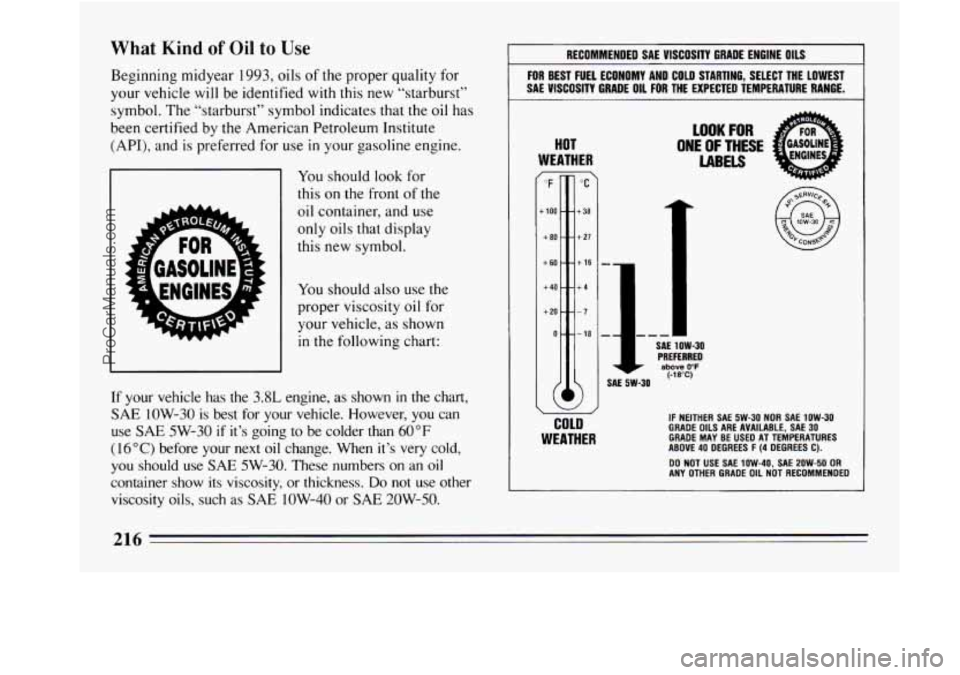
What Kind of Oil to Use
Beginning midyear 1993, oils of the proper quality for
your vehicle will be identified with this new “starburst”
symbol. The “starburst” symbol indicates that the oil has
been certified by the American Petroleum Institute
(API), and is preferred for use in your gasoline engine.
w
You should look for
this on the front of the
oil container, and use
only oils that display
this new symbol.
You should also use the
proper viscosity oil for
your vehicle, as shown
in the following chart:
If your vehicle has the
3.8L engine, as shown in the chart,
SAE 1OW-30 is best for your vehicle. However, you can
use
SAE 5W-30 if it’s going to be colder than 60°F
(16°C) before your next oil change. When it’s very cold,
you should use
SAE 5W-30. These numbers on an oil
container show its viscosity,
or thickness. Do not use other
viscosity oils, such as
SAE 1OW-40 or SAE 2OW-50.
RECOMMENDED SA€ VISCOSITY GRADE ENGINE OILS
FOR BEST FUEL ECONOMY AND COLD STARTING, SELECT THE LOWEST
SAE VISCOSITY GRADE
OIL FOR THE EXPECTED TEMPERATURE RANGE.
HOT
WEATHER
COLD
WEATHER
iOOK FOR
ONE OF THESE
LABELS
IF NEITHER SAE 5W-30 NOR SAE 1OW-30 GRADE OILS ARE AVAILABLE, SAE 30 GRADE MAY BE USED AT TEMPERATURES
ABOVE 40 DEGREES F (4 DEGREES C).
ANY OTHER GRADE OIL NOT RECOMMENDED DO NOT USE SAE 1W-40, SAE 2OW-50 OR
216
ProCarManuals.com
Page 219 of 308
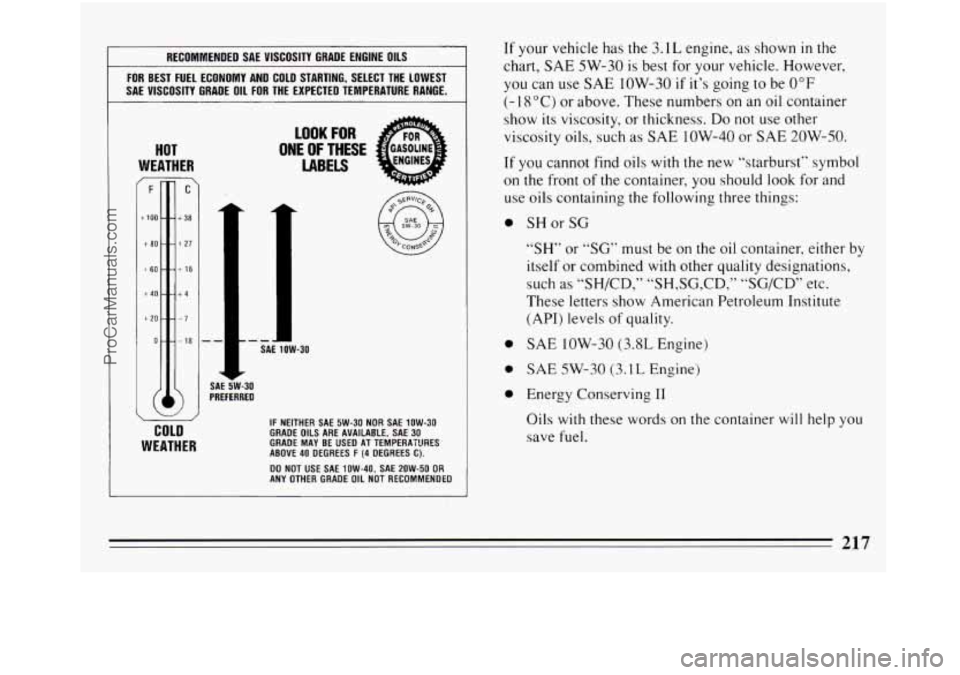
RECOMMENDED SAE VISCOSITY GRADE ENGINE OILS
FOR BEST FUEL ECONOMY AND COLD STARTING, SELECT THE LOWEST
SAE VISCOSITY GRADE
OIL FOR THE EXPECTED TEMPERATURE RANGE.
HOT
WEATHER
r
COLD
WEATHER
LOOK FOR
ONE OF THESE
LABELS
SAE 1OW-30
r
f-30 RED
IF NEITHER SAE 5W-30 NOR SAE 1OW-30
GRADE OILS ARE AVAILABLE, SAE 30
GRADE MAY BE USED AT TEMPERATURES
ABOVE 40 DEGREES
F (4 DEGREES C).
ANY OTHER GRAOE OIL NOT RECOMMENOEO DO NOT USE SAE 1OW-40, SAE 2OW-50 OR
If your vehicle has the 3.1 L engine, as shown in the
chart, SAE
5W-30 is best for your vehicle. However,
you can use SAE
low-30 if it’s going to be 0°F
(- 18 “C) or above. These numbers on an oil container
show its viscosity, or thickness.
Do not use other
viscosity
oils, such as SAE 1OW-40 or SAE 20W-50.
If you cannot find oils with the new “starburst” symbol
on the front of
the container, you should look for and
use oils containing the following three things:
0
0
0
0
SH or SG
“SH” or “SG” must be on the oil container, either by
itself or combined with other quality designations,
such as “SH/CD,” “SH,SG,CD,” “SG/CD” etc.
These letters show American Petroleum Institute
(API) levels of quality.
SAE
low-30 (3.8L Engine)
SAE 5W-30 (3.1L Engine)
Energy Conserving I1
Oils with these words
on the container will help you
save fuel.
217
ProCarManuals.com
Page 220 of 308
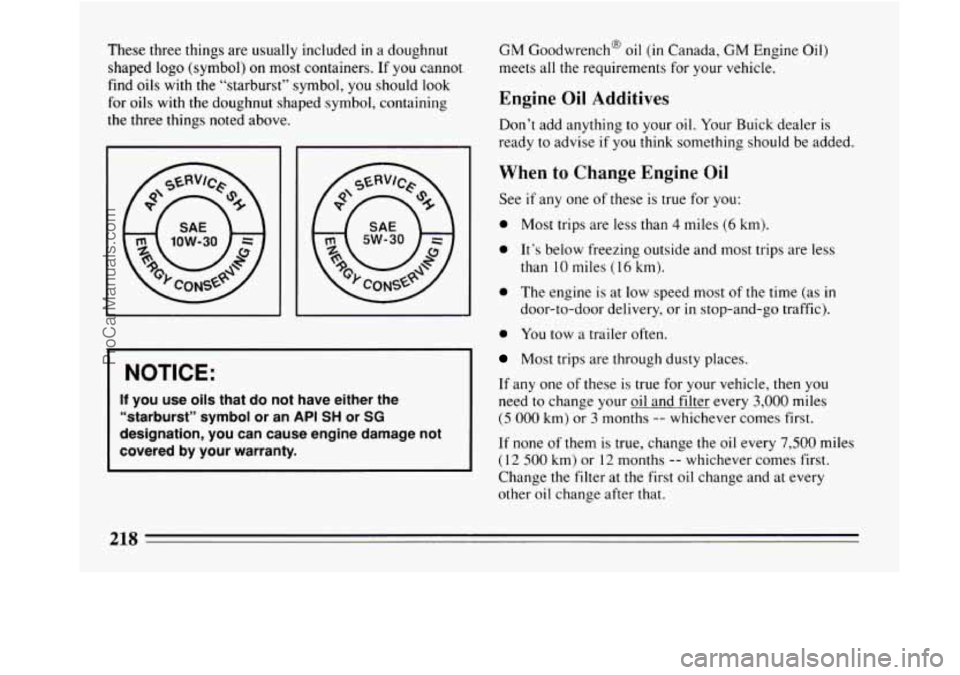
These three things are usually included in a doughnut
shaped logo (symbol)
on most containers. If you cannot
find
oils with the “starburst” symbol, you should look
for oils with the doughnut shaped symbol, containing
the three things noted above.
I NOTICE:
If you use oils that do not have either the
“starburst” symbol or an
API SH or SG
designation, you can cause engine damage not
covered by your warranty.
GM Goodwrench@ oil (in Canada, GM Engine Oil)
meets all the requirements for your vehicle.
Engine Oil Additives
Don’t add anything to your oil. Your Buick dealer is
ready to advise
if you think something should be added.
When to Change Engine Qil
See if any one of these is true for you:
0 Most trips are less than 4 miles (6 km).
0 It’s below freezing outside and most trips are less
than
10 miles ( 16 km).
0 The engine is at low speed most of the time (as in
door-to-door delivery, or in stop-and-go traffic).
0 You tow a trailer often.
Most trips are through dusty places.
If any one of these is true for your vehicle, then you
need to change your oil and filter every
3,000 miles
(5 000 km) or 3 months -- whichever comes first.
If none of them is true, change the oil every 7,500 miles
(12 500 km) or 12 months -- whichever comes first.
Change the filter at the first oil change and at every
other
oil change after that.
218
ProCarManuals.com